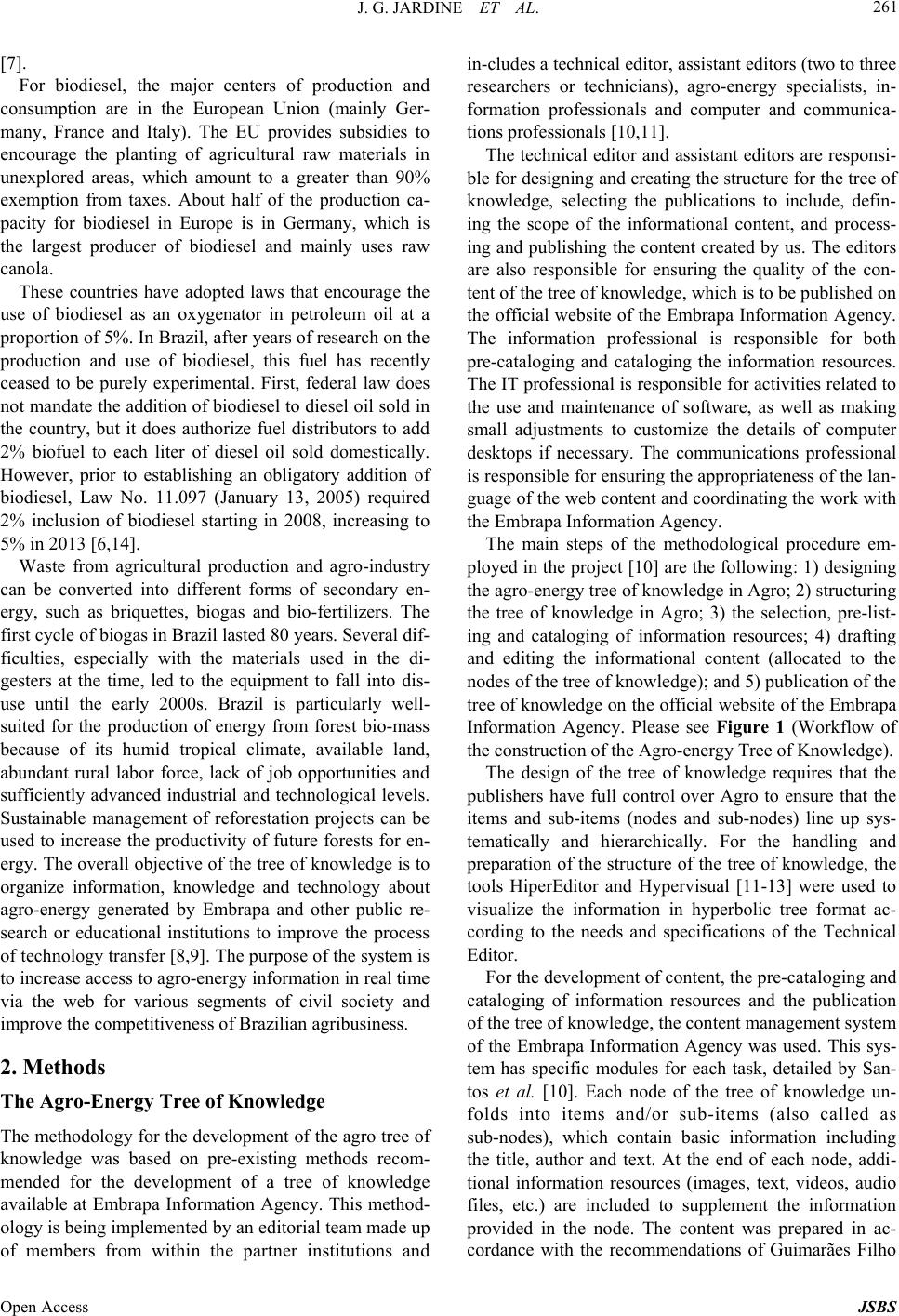
J. G. JARDINE ET AL. 261
[7].
For biodiesel, the major centers of production and
consumption are in the European Union (mainly Ger-
many, France and Italy). The EU provides subsidies to
encourage the planting of agricultural raw materials in
unexplored areas, which amount to a greater than 90%
exemption from taxes. About half of the production ca-
pacity for biodiesel in Europe is in Germany, which is
the largest producer of biodiesel and mainly uses raw
canola.
These countries have adopted laws that encourage the
use of biodiesel as an oxygenator in petroleum oil at a
proportion of 5%. I n Br azil, af ter year s of r esearch o n th e
production and use of biodiesel, this fuel has recently
ceased to be purely experimental. First, federal law does
not mandate the addition of biodiesel to diesel oil sold in
the country, but it does authorize fuel distributors to add
2% biofuel to each liter of diesel oil sold domestically.
However, prior to establishing an obligatory addition of
biodiesel, Law No. 11.097 (January 13, 2005) required
2% inclusion of biodiesel starting in 2008, increasing to
5% in 2013 [6,14].
Waste from agricultural production and agro-industry
can be converted into different forms of secondary en-
ergy, such as briquettes, biogas and bio-fertilizers. The
first cycle of biogas in Brazil lasted 80 years. Several dif-
ficulties, especially with the materials used in the di-
gesters at the time, led to the equipment to fall into dis-
use until the early 2000s. Brazil is particularly well-
suited for the production of energy from forest bio-mass
because of its humid tropical climate, available land,
abundant rural labor force, lack of job opportunities and
sufficiently advanced industrial and technological levels.
Sustainable management of reforestation projects can be
used to increase the productivity of future forests for en-
ergy. The overall objective of the tree of knowledge is to
organize information, knowledge and technology about
agro-energy generated by Embrapa and other public re-
search or educational institutions to improve the process
of technology tran sfer [8,9]. The purpose of the system is
to increase access to agro -energy information in real time
via the web for various segments of civil society and
improve the competitiveness of Brazilian agribusiness.
2. Methods
The Agro-Energy Tree of Knowledge
The methodology for the development of the agro tree of
knowledge was based on pre-existing methods recom-
mended for the development of a tree of knowledge
available at Embrapa Information Agency. This method-
ology is being implemented by an editorial team made up
of members from within the partner institutions and
in-cludes a technical editor, assistan t editors (two to three
researchers or technicians), agro-energy specialists, in-
formation professionals and computer and communica-
tions professional s [10,11].
The technical editor and assistant editors are responsi-
ble for designing and creating the structure for the tree of
knowledge, selecting the publications to include, defin-
ing the scope of the informational content, and process-
ing and publishing the content created by us. The editors
are also responsible for ensuring the quality of the con-
tent of the tree of k nowledg e, which is to be pub lish ed on
the official website of the Embrapa Information Agency.
The information professional is responsible for both
pre-cataloging and cataloging the information resources.
The IT professional is responsible for activities related to
the use and maintenance of software, as well as making
small adjustments to customize the details of computer
desktops if necessary. The communications professional
is responsible for ensuring the appropriateness of the lan-
guage of the web content and coordinating the work with
the Embrapa Information Agency.
The main steps of the methodological procedure em-
ployed in the project [10] are the following: 1) designing
the agro-energy tree of knowledge in Agro; 2) structuring
the tree of knowledge in Agro; 3) the selection, pre-list-
ing and cataloging of information resources; 4) drafting
and editing the informational content (allocated to the
nodes of the tree of knowledge) ; and 5) publicatio n of the
tree of knowledge on the official website of the Embrapa
Information Agency. Please see Figure 1 (Workflow of
the construction of the Agr o-e ner gy T ree of Kno wl ed ge) .
The design of the tree of knowledge requires that the
publishers have full control over Agro to ensure that the
items and sub-items (nodes and sub-nodes) line up sys-
tematically and hierarchically. For the handling and
preparation of the structure of the tree of knowledge, the
tools HiperEditor and Hypervisual [11-13] were used to
visualize the information in hyperbolic tree format ac-
cording to the needs and specifications of the Technical
Editor.
For the development of content, the pre-cataloging and
cataloging of information resources and the publication
of the tree of knowledge, the content management system
of the Embrapa Information Agency was used. This sys-
tem has specific modules for each task, detailed by San-
tos et al. [10]. Each node of the tree of knowledge un-
folds into items and/or sub-items (also called as
sub-nodes), which contain basic information including
the title, author and text. At the end of each node, addi-
tional information resources (images, text, videos, audio
files, etc.) are included to supplement the information
provided in the node. The content was prepared in ac-
cordance with the recommendations of Guimarães Filho
Open Access JSBS